What is an IBM 1401?
A 1401 - History and Fundamentals by Robert Garner
I (Ed Thelen) am qualified to tell you because I used to maintain G.E. Computer equipment
trying to compete with the 1401 - and I know all too well!
 Basic IBM 1401
Basic IBM 1401
with added memory
16,000 characters max.

this system had tapes

a guide to the drawings

1401 Core
Simon Barratt image
| The 1401 computer, introduced in 1959, used discrete transistors
to provide decimal (0-9) addressing
and arithmetic. It provided an effective way for card data processing shops
to convert to "computers". The 1402 card reader/punch was excellent,
the 1403 printer was superb. Interfaces
to magnetic tape drives, discs, and other peripherals were available.
The 1401 software was very "primitive". No operating system, no graphical user's interface,
no windows, - in other words, only your code was running, and you had a chance
of knowing what was going on. :-))
Obviously things had to get better, and we can now blame Bill Gates for
everything - everyone agrees this is an improvement??
The 1401 system was really "user friendly" - say the machine stopped because there
were no cards in the card reader. You looked at the Operator's Panel,
and there was the Card Read instruction. You the operator put a tray of cards
into the card reader, depressed a button, the machine started to run
again - and life was good - and simple :-)
Why did we have to "improve" things?
The 1401 has an unusual architecture, which uses "word marks"
to show the end of numbers or fields. It is easy to play with *big*
exact numbers. Say you have
two 30 digit numbers on an 80 column IBM card. You want to multiply them and print the
result. You issue a card read instruction, and the two numbers are read into memory,
in decimal format. You set two word marks to define the high ends of the
30 digit input numbers, and set a word mark in the print area to define the
high end of
the resultant 60 digit multiply. Do a multiply sending the result to the
print area, and issue a print command and the 60 decimal digit answer is on the paper
in the printer. - Just try that with your 32 bit binary word Pentium C++ Windows
GUI machine.
Folks interested in the definition and development of the 1401 computer and
the 1403 printer are
recommended to "IBM's Early Computers" by Bashe, Johnson, Palmer & Pugh, 1986,
MIT Press, pages 459-495. (Available 2nd hand) - to whet your appetite -
The French proposed the transistor technology,
ferrite-core memory and variable-word-length characteristic
in a June 1955 conference in Sindelfingen Germany. The Americans worried about
offshore development in small laboratories and did the design in Endicott.
The 702-705 field terminating character was replaced in the 1401 by a
special (8th) bit. It was also determined that a plug board added a great
deal of cost and was eliminated. :-))
|
> Can the IBM 1401 be considered the very first fully transistorized (commercial) computer?
Answer from Robert Garner
|
Heavens no!
My IEEE History Network "Early Popular Computers" article includes a table of all transistorized computers before the 1401:
http://ethw.org/Early_Popular_Computers,_1950_-_1970,
"Philco was one of the first out in 1958 with its all solid-state, large-scale, scientific S-2000 Transistorized Automatic Computer. Using its innovative high-speed surface-barrier transistor, it competed with IBM s later large-scale scientific 7090 Data Processing System. The Electrologica company in the Netherlands also delivered its medium-scale, solid-state, scientific X1 computer that same year.
Although the IBM 1401 Data Processing System was not the earliest solid-state commercial computer, it rapidly became the world s most widely used and held that distinction through most of the 1960s [Figure 5]. The story behind the 1401 s success is explained in part because it targeted the small-business punched-card user marketplace while leveraging IBM s mass-production capabilities and worldwide customer support organization, as described next in a case study of its product development."
- Robert
|
Some IBM 1401 web links:
1964 Ballistic
Research Labs report,
IBM,
Columbia University,
Tom Van Vleck,
Van Snyder's 1401 links,
mine
IBM 1405 disk storage
1401 Data Processing System from IBM web site
YouTube Presentations
Full 3D working simulation of a 1401 system
|
There is a startlingly realistic 3D Simulation (with sound) available to view on YouTube and to download to experiment.
It was and is being developed by Michael Schuetz. He often uses the pseudonym "rolffson.de".
You can:
- key punch cards on a simulated 026,
- place the simulated cards in the read hopper of the simulated 1402,
- press the simulated LOAD button on the simulated 1401,
- look at simulated memory using the simulated keys on the simulated 1401,
- print part of simulated memory onto a simulated 1403, using the simulated keys on the simulated 1401,
etcetera, etcetera, and so on ...
This IBM 1401 3D Simulator seems complete enough to assist in training new 1401 programmers, 1401 demonstrators (and is a good refresher for old operators).
A program such as this can give the "feel" of computer systems no longer functioning or existing.
The effort to generate such would be an extended (many year) "labor of love".
The website is here.
The introduction is here
https://www.youtube.com/channel/UCySbM3WTIRsgEqHe3zwA_Nw/featured
continuing on
https://www.youtube.com/watch?v=Yd163rALtHc
and, as of August 2021, about 15 others ...
"Prepare to be blown away" :--))
Download area, executables apparently for Windows 10 only.
On August 29, 2021,
developer Michael Schuetz wrote:
"Regarding a Mac version: For the 3D rendering, the simulator uses the
UnrealEngine (UE), in public renown as a basis for big video games like e.g. the notorious ‘Fortnite’.
Unfortunately UE development for a Mac is only possible on a Mac itself (no crosscompiler), and the
UE development environment is far from optimized for a Mac at all.Using it would require unreasonable
investments since using it on my current MacbookPro is a pain despite the built-in GPU, and would
also require several days of review work, since up to now I didn’t consider to avoid Windows specific
coding for that reason.
So providing a Mac version is possible, however currently isn’t feasible for me, at least not in the
short term.There’s now a new version 5 of the UnrealEngine on the rise, promising better Mac support; possibly I’ll have a look again one day.
"Concerning the training of new 1401 programmers, as mentioned on your main page:since it uses a game engine,
it may require a minimum of graphics power. Tweaking with the graphics settings in the main menu could offer
a chance to get it running on non-gaming PCs, but I don’t have any greater experience.
"With regard to the handling: the latest version (0.2.11) provides some help dialogs when starting the simulation
or clicking on the objects. The explanations are not yet comprehensive, but maybe it helps a little to get a start.
I’ll expand the help system gradually over time."
(Ed Thelen here) - I asked if there is a Mac version.
Michael responded in part (October 16, 2021)
"There's now a Mac version available on the download page at
https://rolffson.de/1401/download/1401VDC/APPLE_MAC/
I was able to strip all OS specific code from the project, so that I could continue to do all development on a Windows PC, and then just copy it over to the Mac for compiling and packaging.
If you like, you may give it a try. Any feedback is welcome."
|
1401CharacterSets
-
SIMH, 029, Fortran, ROPE, ... from Marc
-
Changes getween Paul Pierce and SIMH from Marc
Finally. I got my answer. It was in your SIMH source file Luca.
> ROPE/SIMH is using
> ! SIMH 1401 BCD encoding:
> !
> ! Numeric b 1 2 3 4 5 6 7 8 9 0 3 4 5 6 7
> ! Rows b 8 8 8 8 8
> ! ===========================================
> ! No zone 1 2 3 4 5 6 7 8 9 0 # @ : > ( 000-017 = 00-0F
> ! 0 zone A ^ / S T U V W X Y Z ' , % = \ + 020-037 = 10-1F
> ! 11 zone B - J K L M N O P Q R ! $ * ] ; _ 040-057 = 20-2F
> ! 12 zone BA & A B C D E F G H I ? . ) [ < " 060-077 = 30-3F
> !
> ! ' is 0-2-8, and ^ has no input punch
> ! (it may punch as zero on output).
>
>
> The tape emulator is using:
> ! Pierce's primary BCD encoding:
> !
> ! Numeric b 1 2 3 4 5 6 7 8 9 0 3 4 5 6 7
> ! Rows b 8 8 8 8 8
> ! ===========================================
> ! No zone 1 2 3 4 5 6 7 8 9 0 # @ : > { 000-017 = 00-0F
> ! 0 zone A ^ / S T U V W X Y Z | , % ~ \ " 020-037 = 10-1F
> ! 11 zone B - J K L M N O P Q R ! $ * ] ; _ 040-057 = 20-2F
> ! 12 zone BA & A B C D E F G H I ? . ) [ < } 060-077 = 30-3F
>
> Hence the substitutions, most of them I had noticed,
> but a couple I didn t know what SIMH used:
> into | (for extended memory addresses)
> = into ~ (Word Separator, or word mark prefix on tape)
> ( into { (Tape Mark)
> into } (Group Mark)
> + into (Segment Mark, whatever that is)
>
> There is no error in the emulator, just another choice of
> ASCII encoding for few characters that have no ASCII representation
> to start with on the 1401.
> SIMH is just as arbitrary...
> Some of the non-printable characters were later defined on the 029
> which adheres to IBM definition of EBCD,
> and are unfortunately different from these two tables above.
> I m going to sum it all up in a big table.
> Marc
|
1402 Card Reader Character Set
"IBM CARD CHARACTER CODE"
Ken Shirriff (Sept. 23, 2015) sent the following
RPQ makes DE and CT machines read and punch A bit differently
|
You might be interested to know that the DE and CT machines punch one character differently. I was comparing the DE and CT 1401s and discovered that the CT machine has the A bit RPQ, but the DE machine does not. In a standard 1401 (DE), an A bit is punched as a 0. But on the CT machine, an A bit is punched as 8-2. With some help from Stan, I verified this behavior in the lab.
The relevant character is an A bit with no digit (a blank with an A zone bit), not to be confused with a zero with an A bit.
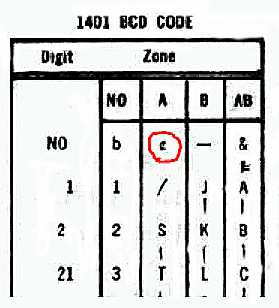 One consequence of this is that you can't read this character into the DE machine (since it is punched and read as 0), but you can read it into the CT machine.
One consequence of this is that you can't read this character into the DE machine (since it is punched and read as 0), but you can read it into the CT machine.
This RPQ is in the CT ALDs under 36.23.11.2.
The custom feature guide explains the RPQ:
Header/Punch Card Code 8-2 and A-Bit Compatibility # 898148 (1401 Model A, B, C, E, or F)
This feature provides A-bit compatibility between 1401 and 1410 systems. It reads 8-2 punching and translates to an A-bit in storage. An A-bit in storage punches out as an 8-2. It is not switch controlled.
|
Mike Albaugh comments
| " [your web page] calls the
12-4-8 punch a "square". We always called it a "lozenge"
Also, the "commercial" and "Scientific" character sets
for the 026 were different, although at this point I
only remember that the commercial '&' (12-only) was
a scientific '+', and that the '#' was "something else" :-)
I could have sworn that 12-6-8 was a '+' in 029 code,
but you show it as "Less than", albeit unprintable."
|
John Van Gardner points out
| The earliest machine that I know of that used the 7 bit BCD code was the 702 which evolved from TPM (Tape Processing Machine). The seven track 726 Tape drives used on the 702, 704 and 705 had the tape tracks labeled as 1248ABC. Your 729s have inherited this.
Attached is a pdf file of pages 31-33 of the 702 Preliminary Manual found at:
http://www.bitsavers.org/pdf/ibm/702/22-6173-1_702prelim_Feb56.pdf
I have highlighted in yellow
the pertinent part about the code.
There is some good information about the TPM and 702 around page 213 of the book "IBM's Early Computers" by Emerson W. Pugh.
|
A list of all 64 6 bit codes for the IBM 1401 in binary and collating order from Stan Paddock.
From Bill Worthington, a reference card,  ,
,

And a 1401 card code from Bob Feretich

A 1401 Card Code from Robert Garner
HTMLized
and Sorted by BCD or OCTAL value
TABLE OF UNPRINTABLE CHARACTERS
(from Part No. 451424 - Diagnostic Function Test)
| -LEFT PARENTHESIS | 12 | 5 | 8
|
| MZ-MINUS ZERO | 11 | 0 |
|
| -WORD SEPARATOR | 0 | 5 | 8
|
| AP-APOSTROPHE | 0 | 6 | 8
|
| -TAPE SEGMENT MARK | 0 | 7 | 8
|
| DE-DELTA | 11 | 7 | 8
|
| -GROUP MARK | 12 | 7 | 8
|
| PZ-PLUS ZERO | 12 | 0 |
|
| -RIGHT PARENTHESIS | 11 | 5 | 8
|
| TM-TAPE MARK | | 7 | 8
|
| SE-SEMICOLON | 11 | 6 | 8
|
| CO-COLON | | 5 | 8
|
| LT-LESS THAN | 12 | 6 | 8
|
| | | |
|
Standard Fortran printer carriage control, 1st character:
blank, single space;
1, top of form;
0, double space;
+, overprint (not supported everywhere).
Feel free to consult your friendly Unix man page for the program 'asa' for further reference.
Major Equipment Inventory - incomplete
| Product #
| Name
| Model
| Serial #
| Informal ID
| 1401
| computer
| .
| 1401-40-28421-E4
| .
| 1406
| extended memory
| .
| 1406-40-20066-61
| .
| 1402
| reader/punch
| .
| 1402-1-1600743-C2
| .
| 1403
| printer
| .
| 1403-40-11401-A3
| .
| 729
| tape drive
| V
| 0729-3534825B4
| Green dot
| 729
| tape drive
| V
| 3534949C4
| Red dot
| 729
| tape drive
| IV
| 35-21062-L1
| .
| 729
| tape drive
| II
| 21062
| .
| 729
| tape drive
| II
| 2012
| .
| 077
| Collator
| .
| 077-40-22036
| .
| 083
| Sorter
| .
| 33619
(on casting)
| ?Rusty? ;-))
| | | | | | | | | | | |
Documation Card Reader instructions and software
From: Bill Selmeier [mailto:bills@right-net.com]
Sent: Tuesday, October 10, 2006 4:57 PM
To: Ronald Mak
for when you need it, here is the software [CardRead.zip]
for the Documation Card Reader.
Load this to a directory on a PC, connect the usb cord from
the card reader, fire up cardread.exe. (there are insturctions in
the included word file and the pdf) and use deckview.exe to look at
the file created on your disk. Bill Worthington probably remembers
how this program runs if you have a problem or describe it and I'll
try and help. But the best support is from Brian Knittle who wrote
these programs and made the usb convertor box. He is a museum
volunteer that lives up in Emeryville.
Good Luck...
Bill |
Source of IBM Punched Cards
|
from Robert Garner - December 8, 2021
from Robert Garner - January 11, 2020 -
|
Could you please put this PO for purchasing punched cards on our web site (somewhere? :)
|
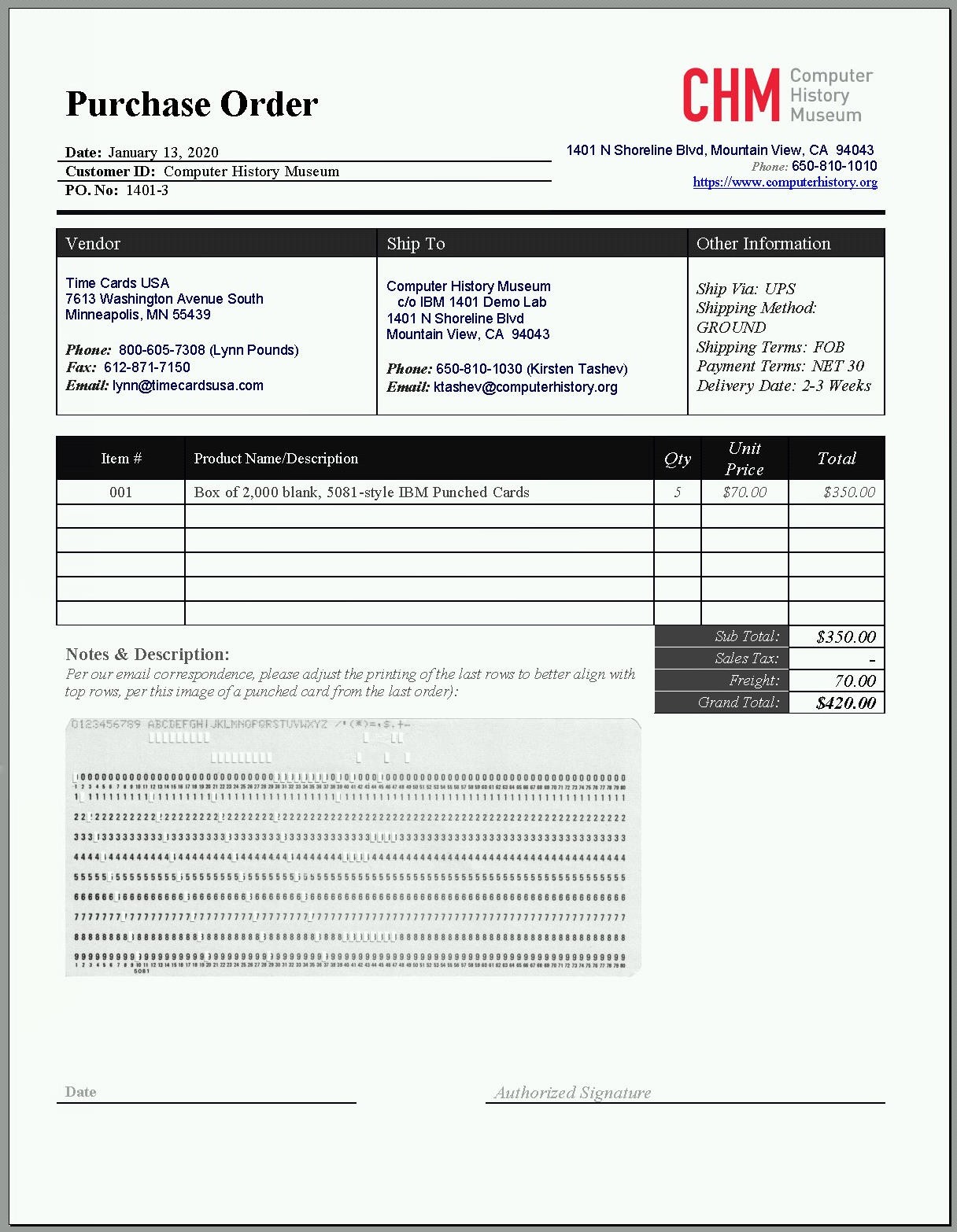
|
from Robert Garner - September 18, 2019 -
Since August 2018, we now have a reliable new source of blank IBM 5081 punched cards:
Time Card Sales (aka Time Cards USA), Tim Beyer proprietor.
Orders can be placed with "Lynn Pounds < lynn@signalsystems.com > at:
Time Cards USA
7613 Washington Avenue South
Minneapolis, MN 55439
Phone: 800-605-7308
Fax: 612-871-7150
Email: sales@timecardsusa.com
We are currently paying $70 per box of 2000 cards.
Tim Beyer's contact info:
Time Card Sales
3869 Thomas St
Memphis, TN 38127
Phone: 901-357-8201
Email: timabeyer@hotmail.com
The paper stock does not technically meet IBM s authentic but demanding card stock spec
CardStockSpecifications.html
...but the cards due seem to work just fine in our Model 26 keypunches and IBM 1402 card reader.
According to Tim, the last supplier of IBM and "US Gov t" spec card stock,
which he called 100-lb tabulating index, was an International Paper mill in Louisiana, shutdown ~2008.
He had supplied 20 - 40k punched cards at a shot to Bob Swartz of Cardamation, Pennsylvania,
our last source of high quality/IBM-spec 5081 cards, whose business closed in 2009 after his death.
Tim calls this paper stock 100-lb manilla tabulating index and his cards imitation 5081 cards."
He isn't completely happy with its quality control, saying that it tends to run 7.4 - 7.7 mils thick,
where his ask is 6.7 - 7.2 mils (or 6.9 - 7.0, I wasn t sure which).
IBM's paper stock spec,
CardStockSpecifications.html
calls for a thickness of 7.0 +- 0.4 mils, or 6.6 - 7.4 mils.
I have measured samples of the cards at an average of 7.0 - 7.2 mils thick.
Tim is proud of his several operating Carroll presses, which he uses to size/cut the paper stock.
However, the print quality is not as high as his (Japanese) time card customers would like.
Thus, he prints cards using a high-quality metal-plate offset printer.
This two-step process introduces the possibility of pattern-to-punched-hole misalignment,
something he addressed after we sent him some sample punched 5081 cards.
|
THE source of IBM cards in the 1950s was - ?? - correct, IBM ;-))
|
This is a receipt for a box (2000) of green 5081 cards, purchased by LaFarr Stuart,
during his student days in 1957,
from an IBM branch office in Salt Lake City, Utah. It was rather clear
to all concerned that this was an unusually small purchase.
|

|
|
A followup from LaFarr One minor detail. Apparently, IBM sold cards by the thousand which at
that time accountants abbreviated with the letter M for a thousand.
That is why there is a 2M on the receipt, even though it was just one
box.
I wonder if today anybody still uses M as an abbreviation? Just for
fun I checked with a 1973 edition of "The American Heritage
Dictionary" and for M it lists 29 uses as an abbreviation. The 28th
is: "M Roman numeral for 1,000 (latin for mile)." I guess that is
where it came from. Today, I think we have gone to the metric
abbreviation. But, sometimes K stands for 1,000 other times 1024. Most
computer geeks know which and everybody else is confused.
|
However
Other folks need "IBM" cards also - and maybe "we" would like to use more per week -
such as reproducing demo decks, output from various assemblies and compilations ...
-------- Original Message --------
Subject: Re: punched cards for IBM 1401 at Computer History Museum
From: Robert Garner < robgarn@me.com >
Date: Mon, August 27, 2018 11:22 pm
To: Tim Beyer < timabeyer@hotmail.com >
Cc: {many}
Tim,
Thanks again for manufacturing/sourcing your TimeCardSales imitation 5081 punched cards!
Following up on my previous email below, here's a photo of one of the newly made cards punched,
showing the misalignment between the numerals and holes
(In our conversation last week, you expected a print spread of but tens of microns? I.e., no more than a 1 mil at most?)
I forgot to ask: Are your vintage Carroll presses (that you used to cut these cards) capable of printing?
While apparently not good enough for one of your time card customers,
the Carroll press print quality might be sufficient for our more modest needs?

click to enlarge
And here is an example of the pattern/logo we d like to get printed on future versions:

click to enlarge
Thanks again for taking this on!
- Robert
> On Aug 15, 2018, at 9:19 PM, Robert Garner wrote:
>
> Tim,
>
> It was great speaking with you today.
> Computing history aficionados and restorers are gong to be delighted hearing that you have an operational Carroll press(!)
and are still manufacturing punched cards! ;-)
>
> I ll send you a photo of the mis-registered numerals on the imitation 5081 punched cards in the next several days.
> They are otherwise working just fine (no jams) for our casual usage (as visitor name cards).
>
> Here s a link to our IBM 1401 restoration web site, with photos of happy Computer History Museum visitors
experiencing our twice-weekly live demos (particularly see second link):
> http://ibm-1401.info/
> http://ibm-1401.info/MoreDemoPhotos.html
>
> Here s a link to IBM s period punched-card paper stock spec on our web site:
> http://ibm-1401.info/CardStockSpecifications.html
>
> It specifies a card thickness of 7.0 +- 0.4 mils, or 6.6 - 7.4 mils.
> Is your time-card thickness spec 6.7 - 7.2 mils, or 6.9 - 7.0 mils? (I wasn t sure which.)
> And you say they have been (unhappily) coming in at 7.4 - 7.7 mils?
> We ll take some thickness measurements of the punched cards that you made for us (10 stacked together ;-).
>
> Duwayne Lafley, (409) 925-8404. is the guy in Santa Fe, Texas who still maintains punched card equipment.
> Here s (one of several) articles about his prime customer, Sparkler Filters, still using an IBM 402 accounting machine(!):
> https://www.chron.com/news/article/Conroe-company-still-using-computers-museums-want-4459714.php
> Photos and reports from one of our field trips there:
> http://ibm-1401.info/402.html
> (Duwayne used to get punched cards from Imation Corp, but I don t think he has a source now that Cardamation closed.
>
> I ll send a pointer to the guy at the TechWorks, aka Center for Technology and Innovation, in Binghamton,
who interfaced their 1442 card unit to their IBM 1440 vintage computer.
>
> Cheers,
|
|
Comments about the IBM 1405, from Dave Bennet
|
The 1405 was a version of the 10 million character RAMAC that was specially configured to interface with the 1401 system. It was the last
version of RAMAC built. It was still in production in 1963 when I transferred into IBM san Jose. It, like other 10 million character RAMACs,
used transistors instead of vacuum tubes.
I think it would be very difficult, if not impossible, to tell any difference in appearance between a 1405 and any other RAMAC, unless
you could see the nameplate or knew the differences of the internals. Heretofore, I have not been aware of any surviving 1405s on the planet.
Dave Bennet
|
Image permissions:
Many of the images on this web site:
a) were photographed by me (Ed Thelen), with frequent contributions by Robert Garner and others,
b) are of property (computers) owned by Computer History Museum.
I am advised by the Museum that Massimo Petrozzi < mpetrozzi@computerhistory.org >
is the media archivist at the Museum and in general, handles requests for image usage.
|
Donations
To donate 1401 specific manuals, equipment or supplies to the project,
e-mail Robert Garner
|
Shutting down the tapes correctly
from Iggy Menendez - Thu, Jul 21, 2016
CHM Tape Restoration Team
-------------------------------------
To all CHM demonstrators doing or assisting on the 1401 System's demos
- Please unload all tapes prior to powering off the 1401 System, to
prevent subsequent hangs of drives on the next power up.
(powering off in the field with the tapes loaded was a NO-NO; it did
happen occasionally due to comp room power outage.)
- When stopping tapes at end of demo, if done from the TAU with all the
drives dialed to the same NUMBER, a subsequent REWIND or REW/UNLOAD from
TAU panel may not rewind all the drives.
This is because it is not a valid operation to run more than ONE drive
with the same number. This may result in leaving one or more drives in
an undefined hung state.
For best results, after stopping the tape forward motion, please REWIND
or REW/UNLOAD each tape individually from its own operator panel.
Rewinding all drives from the TAU may be accomplished by program
control, to each drive with a different number.
This may also be done from the TAU, by dialing each tape drive to a
different number, and executing the command, one at a time, individually
from the TAU panel.
|
Parts Sources
|
from Ignacio Menendez - April 1, 2016 - but I don't think he is kidding ;-))
Hello Ed, I ordered some transistors from this guys last year,
now they have a nice customers' searchable inventory on line,
just click on the attached email's link to try out.
https://www.americanmicrosemi.com
other well know vendors
|
Work Shop 2016, 2017, 2018 (smaller each revision)
| March 2017 - Pretty much moved into the new room, to be shared with the PDP-1 and RAMAC groups.
There were the usual picky items, power outlets covered by sheet rock,
lighting, ..., the Wi-Fi wire now hanging from the ceiling, etc.
| 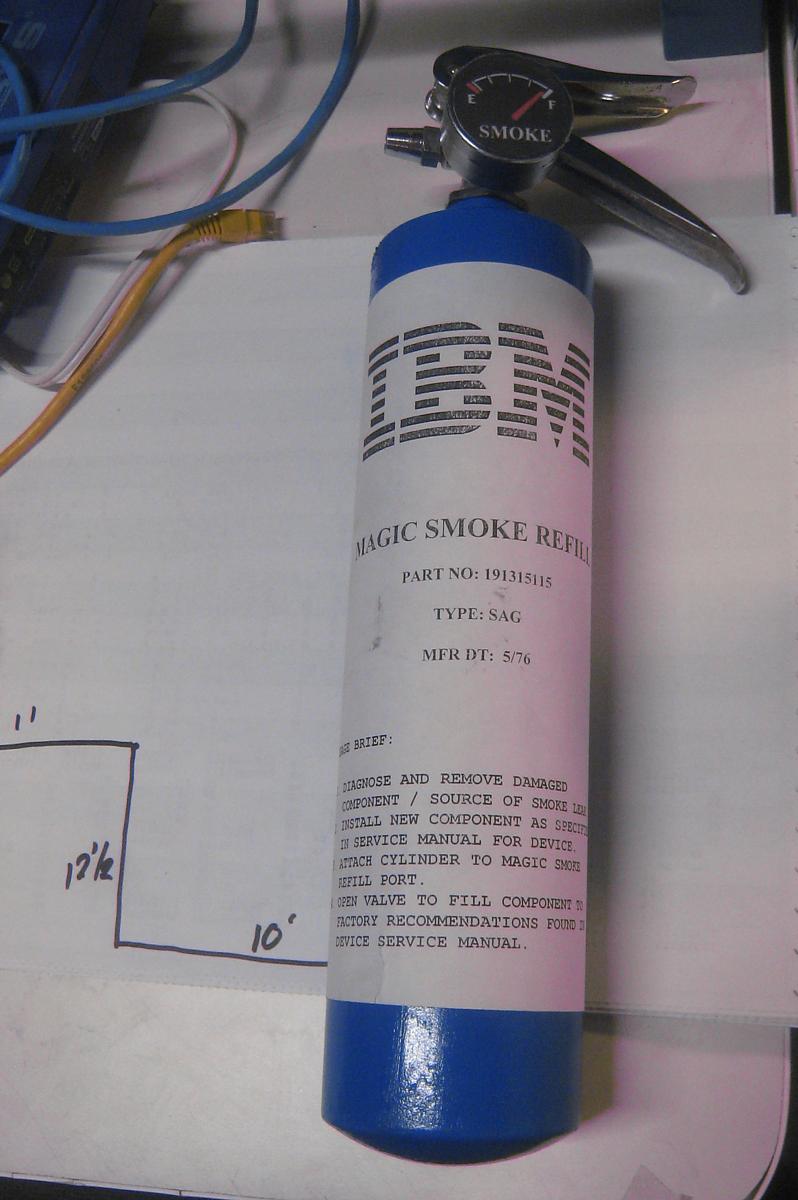 April 1st ;-))
April 1st ;-))
An added feature to aid in restoring failed parts is this container of "Magic Smoke".
Sometimes a part smokes and fails. Evidently the smoke is necessary inside for the part to
work correctly. If you can restore the smoke,
the part can be restored to service. This smoke is guarenteed to be identical to official IBM smoke,
compressed for easy restoration into the failed part.
|

Workshop pre July 7, 2016
|

Location of New Workshop
|
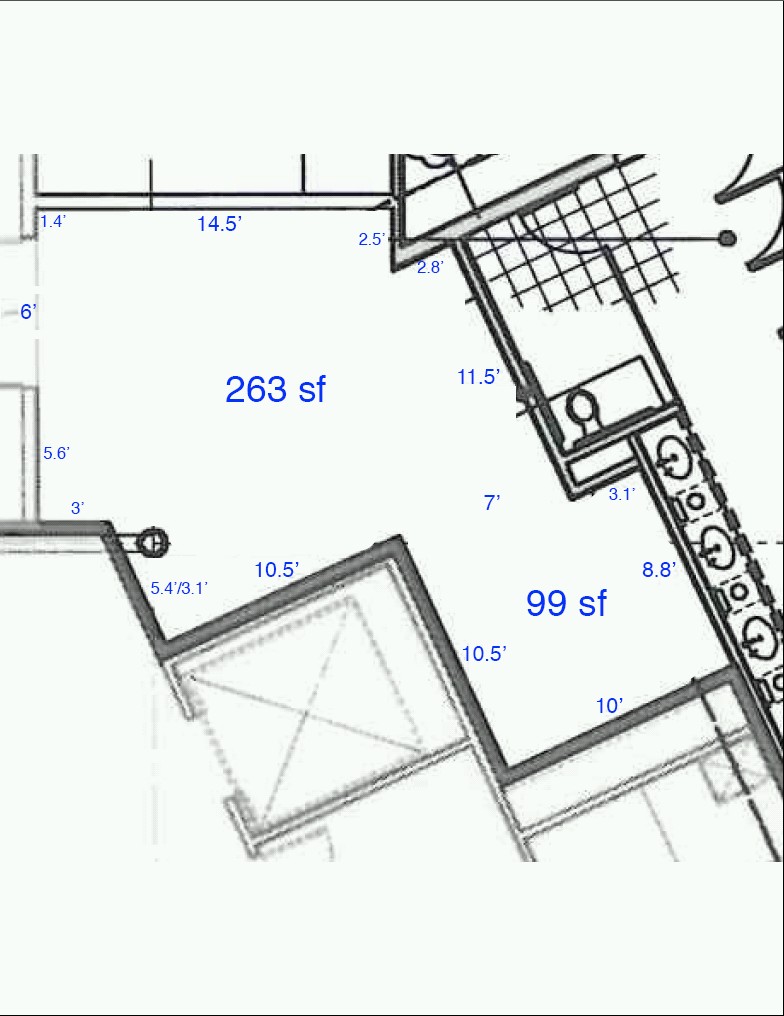
New Workshop post ?Oct? 2016
|

Temporary Workshop
|
Stan Paddock wrote:
"Today, Monday August 8, 2016 the 1401 restoration team endeavored to resolve the cage access problem.
- All items in front of the cage door were relocated.
- A sign was posted to discourage placing any more items that would block access to the door of the cage."
|
from Robert Garner, to CHM administration, Dec 1, 2016
Back in mid September, we requested and you acknowledged that light fixtures would be installed directly
above the workbenches in the new restoration workshop (that I see is nearing completion! :-)).
Ron supplied a floorplan at that time showing the locations of the workbenches.
Here's a new outline/floorplan of the workshop space (word and pdf files attached and pasted below),
reaffirming where we d like to place the workbenches with hanging fluorescent light fixtures above them.
Also, we requested and you acknowledged the installation of sectional floor carpeting in the workshop.
Please let me know if there are any hangups/issues with our two requests or if there s anything else I/we need to do.
Thanks(!),
|
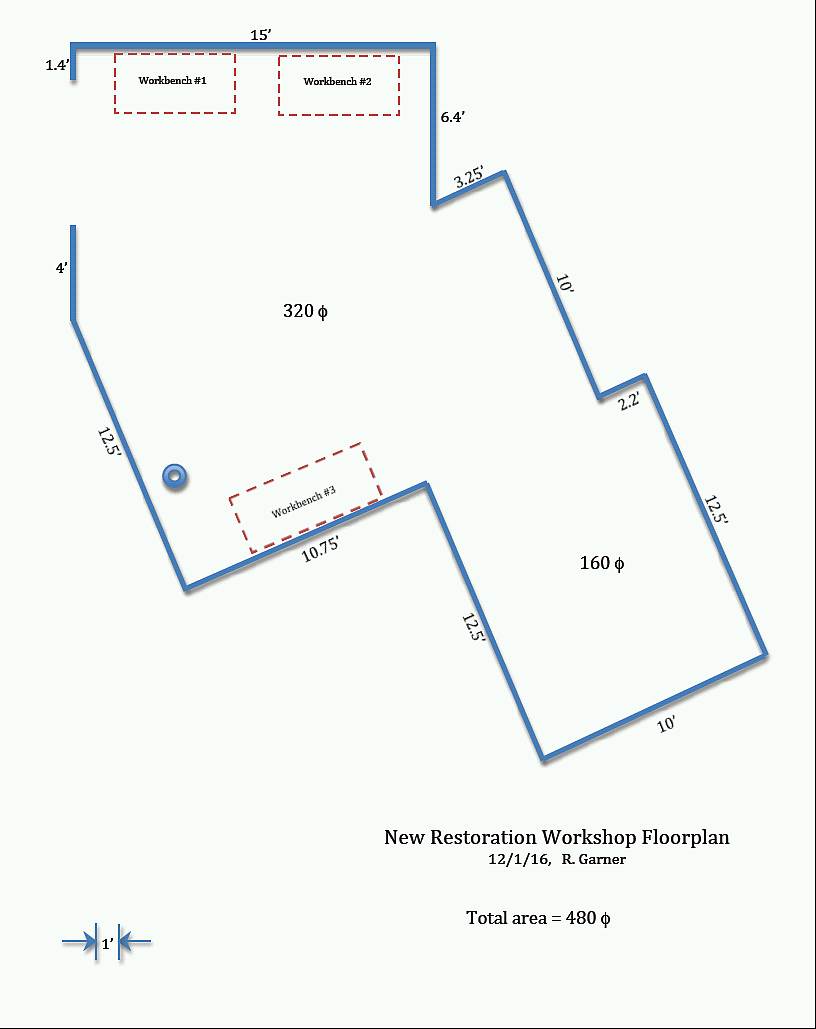
|
June 2018 - Lightning struck again - actually this is getting boring.
We were informed that "Education" needed more room for electrical usage and that "our" work/storage shop will be unavailable
from July 4th to October for that renovation, and will be made smaller. (Do you get the idea that we are not welcome? Or are victims
of some Headquarters Power Play? One restorer quit in protest.)
Here is a summary from Robert Garner dated Oct 24, 2018
|
Restoration team, et al,
Today, after being in the now-open altered workshop, discussing options and measuring the new wall dimensions,
attached is the resulting proposed new floor plan.
|

|
This proposed floor plan assumes:
- retaining the three existing 5 -tall cabinets w/ 7 rollout shelves each,
- a total of five open 18 -deep boltless shelving units:
- a. two existing units
- b. three new units, 8 tall
- replacing the heavy tool cabinet w/ smaller tool box
(locate on left end of mechanical workbench)
- locating refrigerator under electrical workbench #1, right side against wall
- keeping the PDP-1 cabinets (5 wide x 20 deep) in the PDP-1 demo lab (?)
- moving out the Galaxy cabinet (?)
- retaining RAMAC & 1401 file cabinets (could be taller)
- emptying/removing the tall cabinet w/ doors that contains a potpourri of non-1401 ephemera
Photo attached.
We still need to consider/plan for a fire-resistant cabinet for flammable and volatile chemicals.
Total area is ~330 sqft, oddly shaped(!). It was previously ~405 sqft.
(Our original workshop was 350 sqft and a rectangular.)
Thoughts/comments?
- Robert
|
Lyle Bickley of the PDP-1 Restoration/Maintenance Team responded Oct 25, 2018
The Education Department needed space for a "Server Room" - and it was
taken away from the latest incarnation of our Restoration Lab. As of
now, the total area is ~330 sqft and oddly shaped (see attached floor
plan). It was previously ~405 sqft.
It is totally filled with 1401 cabinets, workbenches, etc. (And that's
assuming that a number of the existing 1401 materials are moved to
another storage area - perhaps across the hall from the Lab).
The 1401 Team is asking us if we would be willing to permanently keep
our cabinets where they are now - in the PDP-1 Demo Lab. Of course, we
would still have access to the Restoration Lab workbenches, etc. - just
not cabinet space.
I know it makes our Demo area "cluttered" - but having looked at the
layout of the new "mini" Restoration Lab - I can fully understand their
predicament.
How do you all feel about this?
|
|
We get thank you notes :-))
(started April 2017)
- From some (polite) people at Berkeley April 2017
- from Professor Ron Mak @ SJSU Nov 2022
|
Miniature Model of 1401 System
Virtualized IBM punched cards website
|
from Robert Garner - Nov 30, 2021
Fyi, Carl pointed out this out-of-the-ordinary Github repository on virtualized and printable IBM punched cards:
https://github.com/chkummer/PunchedCard
The site features:
* Java programs that virtually punch, read, and execute — of all things — Python programs.
(small 1401 images are shown on the pages. Someone will need to write a Python interpreter for our 1401. :)
* Linux/MacOS scripts to print and laser-cut paper to match 80-column IBM punched cards.
(pre-specified card types: 5081, Fortran, Cobol, and S/360 assembler)
* Tutorial diagrams from the IBM keypunch field manuals on how the the code plates work and a code plate visualizer/executable:
https://www.masswerk.at/misc/card-punch-typography/
* References to the original 026, 029, and 129 keypunches, 557, ISO standards, etc.
On the “more information page”, I noticed a pointer to an American on-line firm that accepts a scan of a punched-card deck,
figures out the format, and returns the data as a text and html file!
https://punchcardreader.com
"Recovery service for your legacy data and programs. Possibly the last business on Earth that can turn your punch cards back into a database open to the public — and the world since 2005"
We now can point people that way when they come to us with a box of old punched cards. :)
Enjoy,
- Robert
p.s. Here’s an image of the
code plate visualizer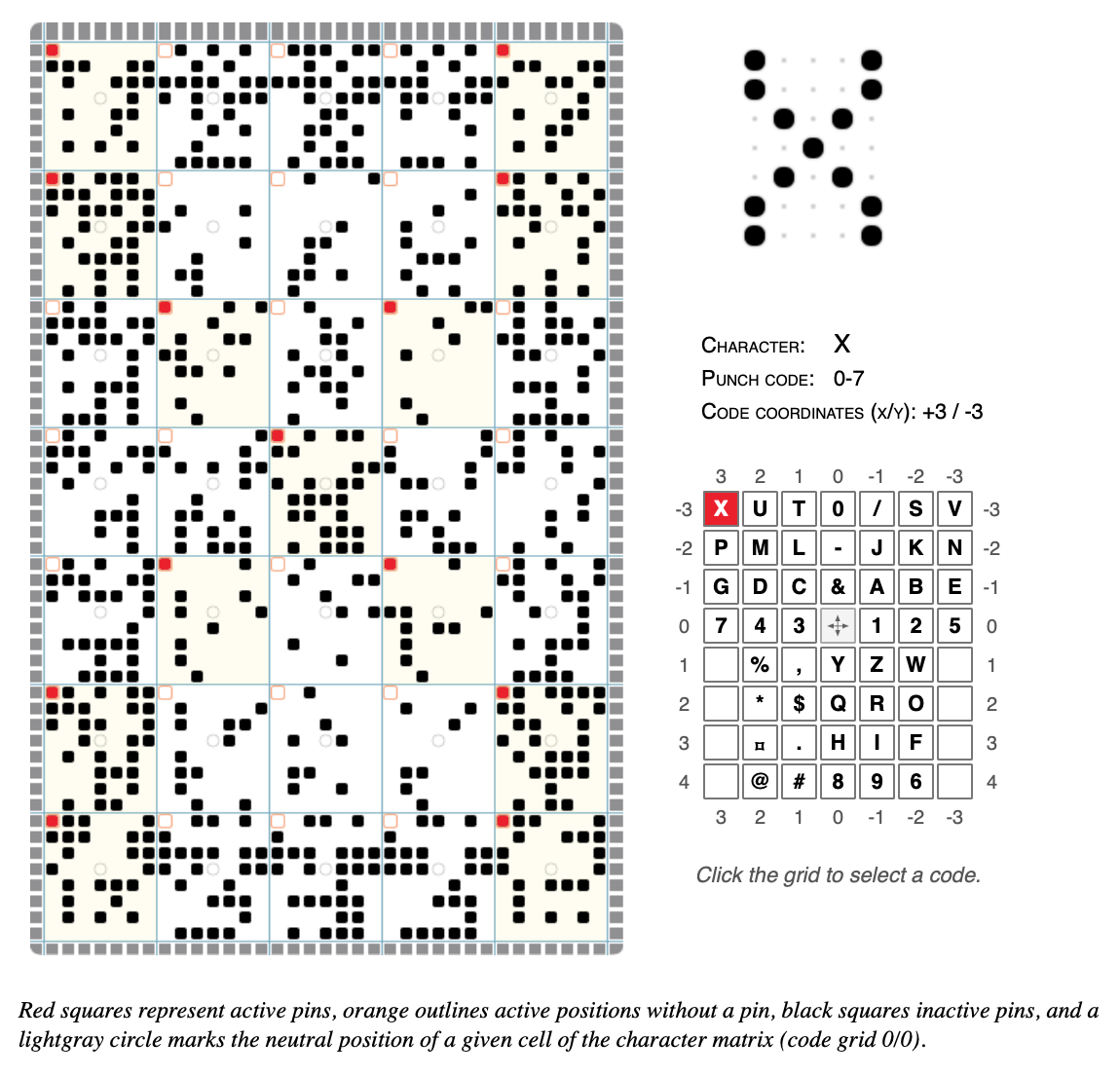
|
Potential fuse miss value for core memory - June 16, 2022
|
Bhushan Mohan, visiting us from India where he worked as a 1401 specialist years ago, pointed out a common error with the cartridge fuses on the 1402 that can result in a very painful, expensive failure.
On the bottom of the 1402, front side, are a set of seven cartridge fuses, all but the right hand one are 5A GLD-5, but the rightmost must be a 3A fuse. This fuse limits the current through the core plane from the reader brushes. As we know it is possible to accidentally ground the brushes which should pop this fuse.
Several nasty failures occurred in the field with machines where someone naively stuck a 5A fuse in that right hand space. The result of grounding the brushes was destruction of the core plane driven by the reader, causing the installation to need a replacement core stack or to take apart and fix the damaged plane.
It is very easy to make the mistake. The seven fuses look the same. They are the same color and size. The warning label over the rightmost position is faded and partially blocked by wires.
In fact, while our CT machine had the proper 3A fuse, the DE machine was found to have a 5A fuse in place. We swapped it for the correct one, but we all need to be careful about this human error that is encouraged by the identical appearance of all seven fuses.
|
1403 Ribbons available in 2024
|
Susan Sherwood, of Center for Technology & Innovation ordered AND RECEIVED ond dozen NOS 1403 printer ribbons from
the OCO supply company.
|
Restoring Dried Ribbons
from Ryan - of Center for Technology & Innovation, Binghamton, NY
|
Susan,
I have some information on what to use for an ink solvent. Please pardon a trip down memory lane for me.
As a young man, I frequently found myself hanging out and helping out (read annoying the hell out of) in the mainframe room at the family data processing department.
Back then (circa late 1980s - early 1990s), we had a row of a half dozen or so 1403 Printers that printed checks and the general ledgers for various family businesses. I remember one summer day, an IBM FE working on one of the printers, and as part of his service, he 'rejuvenated' one of our attic stock printer ribbons. Family lore was that in the early 1980s, IBM ran out of these printer ribbons and shut down operations for a couple of weeks. We purchased a pallet load of the ribbons under the auspices of NEVER running out. This created the issue that the ribbons 'dried out' before use. The IBM FE used two trays, one with Tetrachloroethylene (PERC) and the other with carbon tetrachloride. Each ribbon was submerged in each chemical for a moment and then left to dry on top of an air grate in the mainframe room floor.
This technique is probably highly toxic, but if it works, so be it.
Just my thoughts.
With warmest regards,
Ryan
|
Tool Kit
- from Robert Garner
|
Marc, Dale,
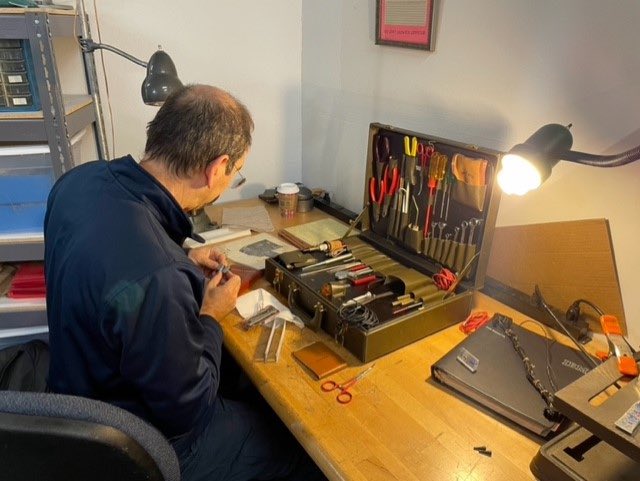
Given that you (Marc) meticulously restocked one
of our 1401-era CE tool briefcases (from several)…
|

… and you (Dale) brought yours in...
|
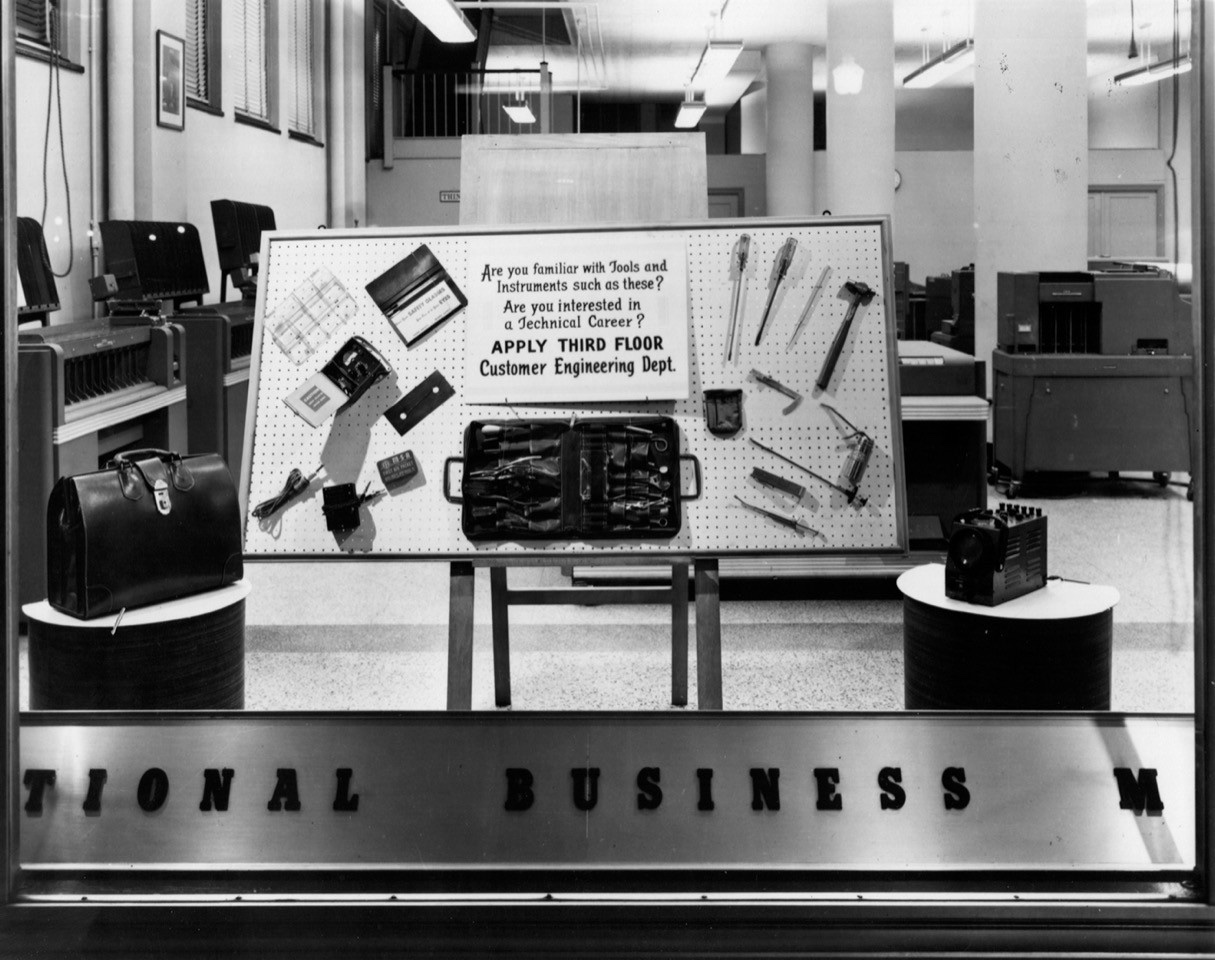
... I thought you two might appreciated this 1950s recruitment ad featuring an IBM tool bag:
Any guesses for the boxy item on the right-side pedestal? A tube tester?
Cheers,
— Robert
|
This page started June 5, 2004
Updated through January 28, 2024
Dreams, ideas, and semi-related items
This website does not use browser cookies.
The web master only knows of cookies you like to eat.
|
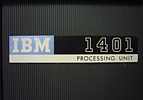
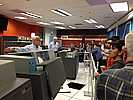
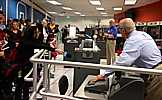

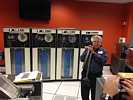


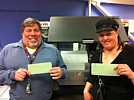
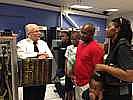
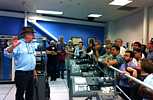

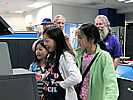


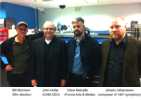
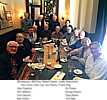

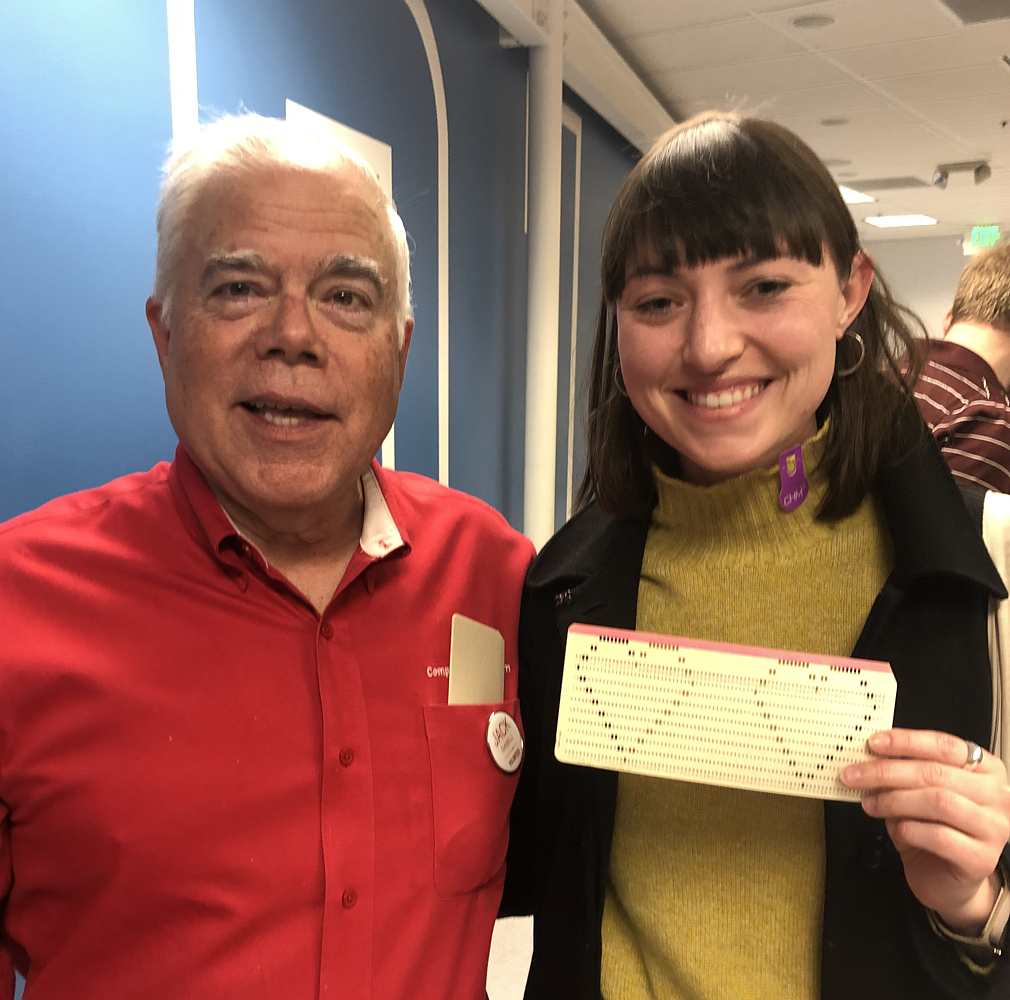





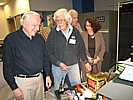
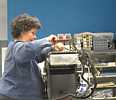
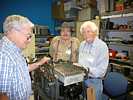
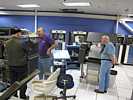

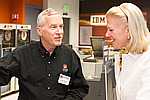
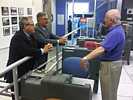
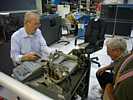
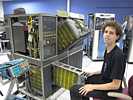
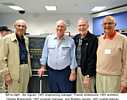
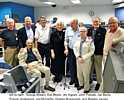
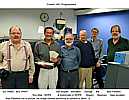
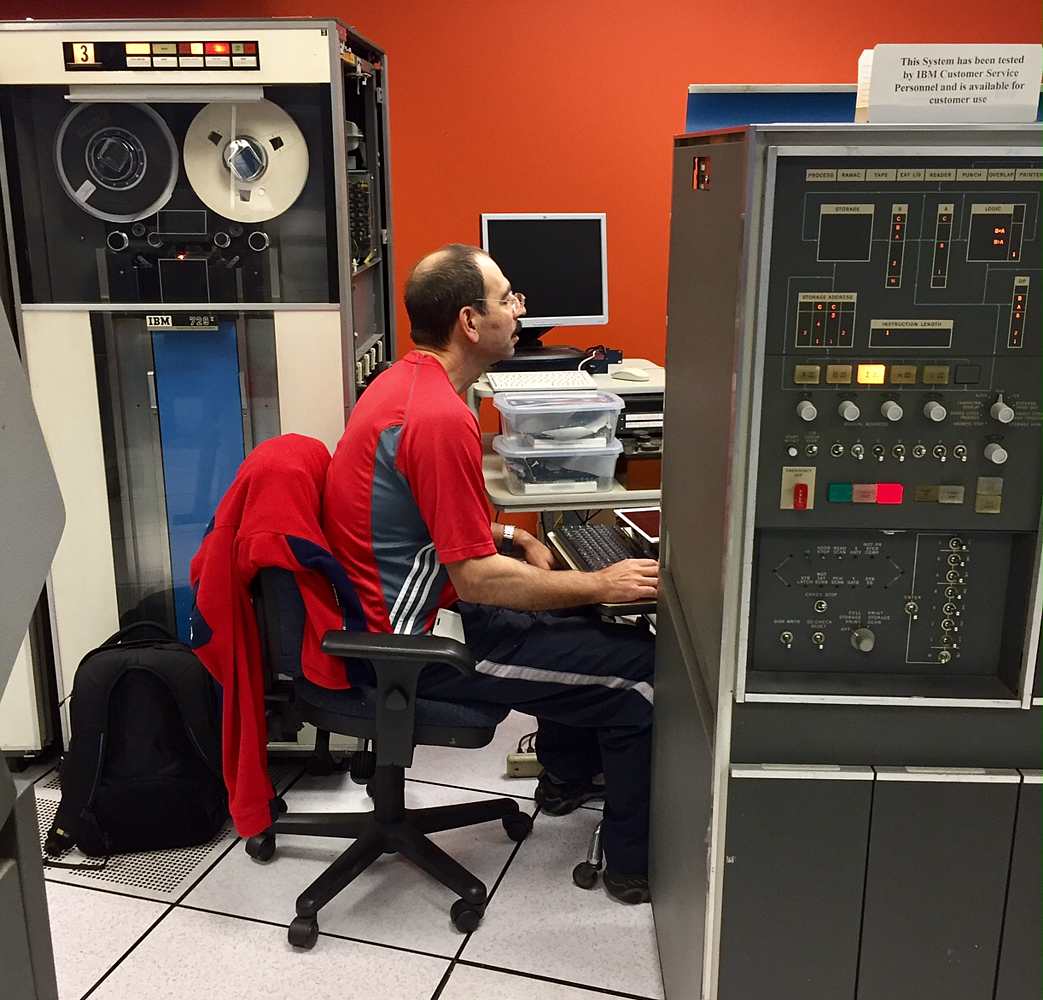




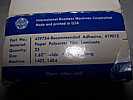
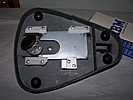
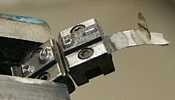



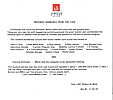




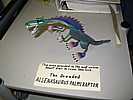






 Basic IBM 1401
Basic IBM 1401


 One consequence of this is that you can't read this character into the DE machine (since it is punched and read as 0), but you can read it into the CT machine.
One consequence of this is that you can't read this character into the DE machine (since it is punched and read as 0), but you can read it into the CT machine.

















